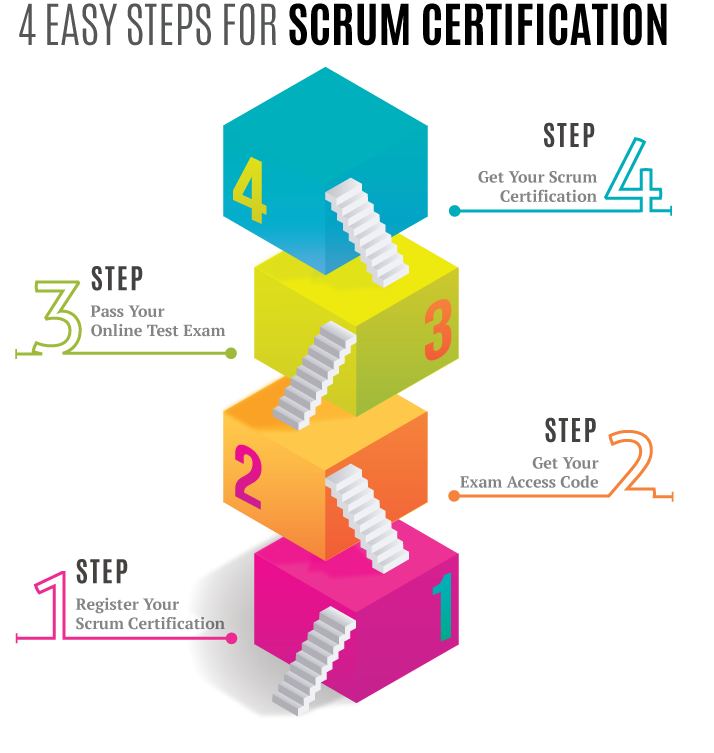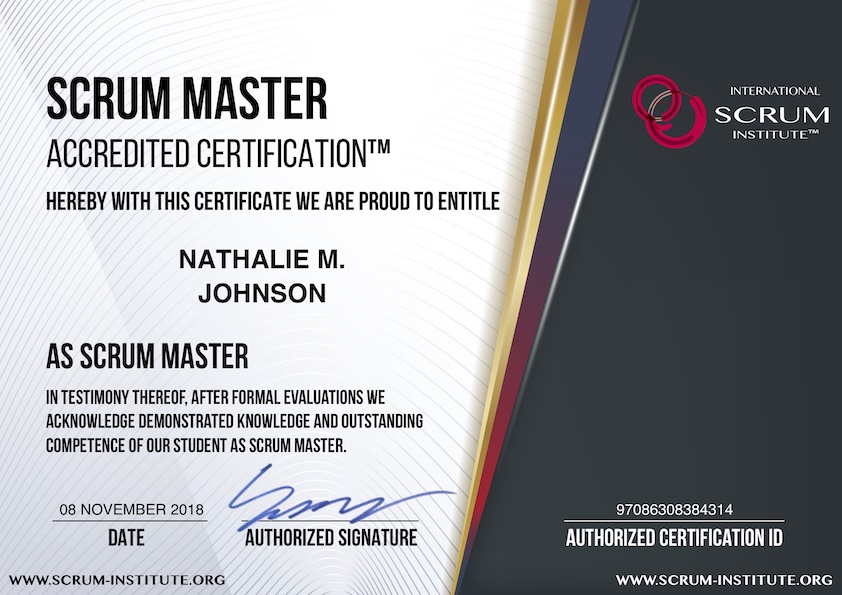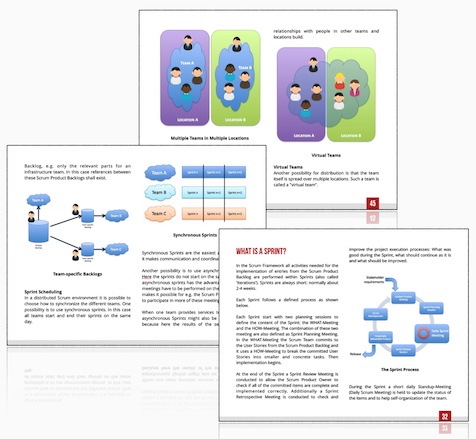Multiple Scrum Teams:
Best Practices for Agile Project Management
Managing multiple Scrum teams is like herding a flock of talented sheep, each team unique yet directed towards the same goal. This method not only improves efficiency and speed, but it also opens doors to handle complex projects encompassing various technical challenges. Surprisingly, it is not just about improving scalability or faster delivery of products but also about leveraging diverse skill sets, ensuring every user story, feature and difficulty is addressed simultaneously. Now, let's delve into how these teams should be structured for optimum results.
Managing and coordinating multiple Scrum teams requires a structured approach, including clear communication channels, synchronized sprint cycles, and regular collaborative sessions such as Scrum of Scrums meetings. It's essential to establish a common Product Backlog, ensure transparency over shared work, and address dependencies to promote successful cross-team collaboration.
 Multiple Scrum Teams
Multiple Scrum Teams
Advantages of Multiple Scrum Teams
When it comes to managing a project, having multiple Scrum teams can offer various benefits that ultimately contribute to improved project outcomes. Let's delve into these advantages in more detail.
Enhanced Scalability
One of the key advantages of having multiple Scrum teams is the enhanced scalability they provide. As a project grows in size or complexity, additional teams can be added to handle the increased workload more effectively. This scalability allows organizations to take on larger projects with confidence, knowing that they have the capacity and resources to support their objectives.
This is particularly beneficial when working on complex projects that require cross-functional collaboration and a diverse range of skills. By distributing the work across multiple teams, each with its own unique expertise, organizations can ensure that no aspect of the project is overlooked and that all necessary skills are utilized efficiently.
Efficient Tackling of Complex Projects
Complex projects often involve various interconnected tasks and dependencies. With multiple Scrum teams, organizations can address these complexities more efficiently by assigning specific components or features to different teams. This parallel working approach allows for simultaneous progress on different aspects of the project, reducing bottlenecks and streamlining overall development efforts.
By breaking down complex projects into manageable chunks and allocating them to individual teams, organizations can maintain a clear focus on each component while ensuring that the project as a whole remains cohesive. This focused approach aids in better project management and reduces the risk of overlooking critical details.
Quicker Delivery of Products or Features
Parallel working, facilitated by multiple Scrum teams, enables quicker delivery of products or features. Each team can work independently on their assigned tasks, leading to concurrent progress across different areas of the project. This parallelism accelerates the development process and reduces time-to-market for new products or features.
Moreover, by leveraging the collective efforts of multiple teams, organizations can optimize their workflows and streamline development cycles. The ability to address user stories, features, and technical challenges concurrently results in a more efficient product development pipeline, benefiting both the organization and end-users.
Increased Flexibility in Resource Allocation
With multiple Scrum teams, organizations gain increased flexibility in resource allocation. They can adjust team sizes based on project requirements, allocate specialized resources to specific teams, and adapt quickly to changing needs. This flexibility enables organizations to respond effectively to evolving project demands and optimize resource utilization based on priority areas.
By aligning resources with specific project components or strategic goals, organizations can maximize productivity and ensure that each team has the support it needs to succeed. This adaptive resource allocation fosters a responsive and dynamic project environment, promoting agility and resilience in the face of shifting project dynamics.
These advantages demonstrate how multiple Scrum teams offer not only increased capacity and efficiency but also an enhanced ability to adapt to evolving project requirements.
As you embark on this journey through agile methodologies, understanding how multiple Scrum teams function is pivotal. Now let's transition into uncovering the intricate art of structuring Scrum teams for maximum efficiency.
Scrum of Scrum
To coordinate the different Scrum Teams "Scrum of Scrum"-Meetings can be used. It is similar to the Daily Scrum but the focus here is on team-level.
The meeting takes place every day and should be limited to e.g. 15 minutes. Each team sends out one member to participate and answer the following questions:
- What did the team finish?
- What does the team plan to finish today?
- Are there any impediments?
The answers should concentrate on the things that impact any other team.
The Chief Scrum Product Owner should moderate the meeting. Participate should not only the Scrum Master of the teams, one approach could also be to shift participation on a daily base within the team.
Common Sprint Reviews
Instead of multiple small Sprint Review meetings a common Sprint Review with all teams could also be used. This will show everyone what has been done within the Sprint and what the status of the project is.
Common Sprint Retrospectives
For the Sprint Retrospective there are two possibilities. The first possibility is that each team has their own Sprint Retrospective meeting followed by a Common Sprint Retrospective where all results are discussed that concern multiple teams.
Another possibility is that topics are collected, selected and then worked on in smaller groups with members of all teams. This approach will take more time but the advantage is that members from multiple teams are closely working together.
Multi-Team Planning - Scrum Product Backlog
Even when working with multiple teams it is important to keep only one common Scrum Product Backlog for all teams. The Scrum Product Backlog shall be maintained by the Chief Scrum Product Owner but is filled by all Scrum Product Owners.
If necessary the items in the Scrum Product Backlog can be broken down into more team-specific stories and maintained in a team-specific Scrum Product Backlog, e.g. only the relevant parts for an infrastructure team. In this case references between these Scrum Product Backlogs shall exist.
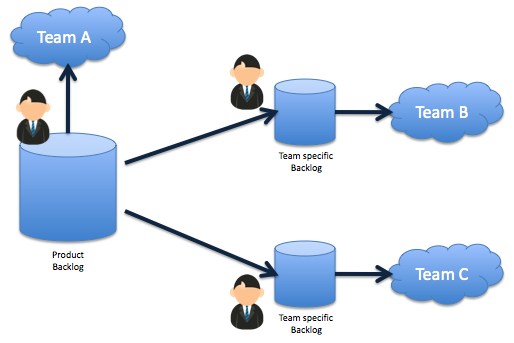 Team-specific Backlogs
Team-specific Backlogs
Sprint Scheduling
In a distributed Scrum environment it is possible to choose how to synchronize the different teams. One possibility is to use synchronous sprints. In this case all teams start and end their sprints on the same day.
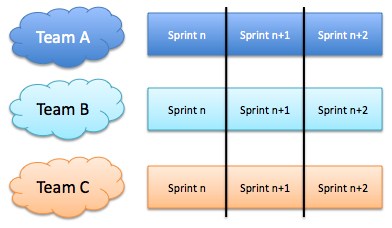 Synchronous Sprints
Synchronous Sprints
Synchronous Sprints are the easiest approach since it makes communication and coordination simpler.
Another possibility is to use asynchronous sprints. Here the sprints do not start on the same day. Using asynchronous sprints has the advantage that not all meetings have to be performed on the same day and makes it possible for e.g. the Scrum Product Owners to participate in more of these meetings.
When one team provides services to other teams asynchronous Sprints might also be a good option because here the results of the service-providing team is already available during the development time of the other teams and could be integrated.
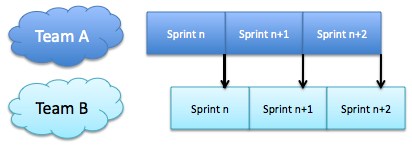 Asynchronous Sprints
Asynchronous Sprints
Effort Estimations
It is important that all items in the Scrum Product Backlog are estimated using the same base for estimation. If story points are used all teams have to agree on the same metric and a common scale to use. If Component Teams are used it is important that members of all teams participate in the estimation to ensure that all efforts are covered.
Structuring Your Scrum Teams
When it comes to maximizing the potential of your multiple Scrum teams, thoughtful structuring is essential. Let's break down two effective team structures—Division by Feature or Component and Matrix Structure—and see how they can benefit your agile project management.
Division by Feature or Component
In this structure, teams are organized based on specific product features or components. For instance, one team may be responsible for the user interface, while another may focus on the database functionality. This segmentation provides numerous advantages:
- Focused Expertise: Each team becomes an expert in their specific domain, allowing for deeper understanding and more effective problem-solving.
- Swift Decision-Making: By being exclusively responsible for specific features, teams can make decisions swiftly without being bottlenecked by dependencies on other teams.
- Faster Delivery: With a dedicated focus on individual features or components, teams can deliver solutions more rapidly, ensuring that each team is more self-contained and productive.
This structure promotes a sense of ownership and accountability within each team, leading to more efficient development cycles and quicker time-to-market for individual product elements.
Matrix Structure
Another approach to structuring multiple Scrum teams is the matrix setup. In this hybrid arrangement, individuals report to both a functional manager (such as a department head) and a project manager overseeing a specific project or initiative. The matrix structure offers several benefits:
- Effective Communication: By having dual reporting lines, information flows more freely between team members and across different functional areas.
- Collaboration-Focused Environment: This structure fosters collaboration as team members from various departments work together on projects, sharing diverse perspectives and expertise.
- Alignment with Organizational Goals: With familiarity in both functional priorities and project objectives, teams are better equipped to ensure their work aligns with broader organizational goals and strategic initiatives.
Both team structures offer unique advantages and considerations. It's crucial to assess your project requirements, organizational culture, and the skill sets of your teams to determine which structure will best support your agile project management needs.
Whether it's leveraging focused expertise through division by feature or component or fostering seamless collaboration via a matrix arrangement, thoughtful structuring lays the foundation for high-performing, cohesive Scrum teams.
Understanding the importance of structuring your Scrum teams is indispensable when striving for optimal performance. Now, let's explore another critical aspect in managing multiple Scrum teams—overcoming communication challenges.
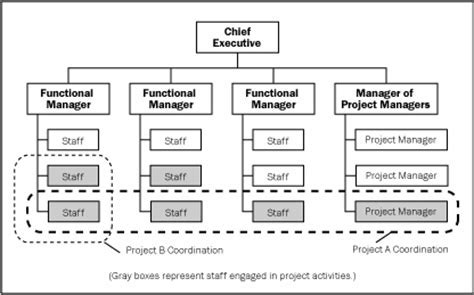 Matrix Organization Structure
Matrix Organization Structure
Overcoming Communication Challenges
When managing several Scrum teams, keeping everyone on the same page can be a daunting task. Effective communication is key to ensure that each team understands their role and dependencies, and is aware of the progress of other teams. Without strong communication, there's a risk of misalignment, duplicated efforts, and missed opportunities for collaboration.
One common challenge faced when dealing with multiple Scrum teams is the breakdown of communication. It's not uncommon for information to get lost or distorted as it moves between teams. This can result in delays, misunderstandings, and ultimately impact the overall project progress.
For instance, imagine one team completes a task that another team was waiting on, but due to poor communication, the second team isn't aware of the completion. As a result, they delay their own work, assuming the first team is still working on the task. This lack of visibility and shared understanding can lead to unnecessary roadblocks.
To address this challenge and promote effective communication across multiple Scrum teams, consider implementing regular Scrum of Scrums meetings and leveraging collaboration tools as part of your Agile project management strategy.
Regular Scrum of Scrums Meetings
Regular Scrum of Scrums meetings provide a platform for representatives from each team to come together, providing updates, synchronizing their work, identifying and addressing inter-team dependencies, and discussing any impediments. These meetings are brief, focused, and time-boxed to ensure efficiency while fostering collaboration and transparency.
For instance, during these sessions, each team representative can share their progress and raise any concerns related to cross-team interactions. This allows everyone to understand how their work impacts others and encourages proactive problem-solving. By having these discussions at regular intervals, potential conflicts or misunderstandings can be identified early and addressed before they escalate.
Use of Collaboration Tools
Leveraging modern collaboration tools such as Jira, Trello, or Microsoft Teams can facilitate seamless communication, share progress updates, track dependencies, and ensure visibility across all teams.
These tools enable real-time information sharing, documentation of decisions and actions taken, and easy access to project-related data. For example, using Jira or Trello boards can provide a visual representation of tasks and their status across different teams. This makes it easier for everyone to see the big picture and identify areas where coordination is required.
By implementing these strategies for overcoming communication challenges in multi-team Agile projects, you can significantly reduce the risk of miscommunication, streamline collaboration, and ensure that all teams are aligned toward achieving common project goals.
Armed with effective methods for managing multiple Scrum teams in an Agile environment such as this, the next journey leads us to explore best practices for forming high-functioning cross-functional teams.
Best Practices for Cross-Functional Team Formation
The success of Agile project management greatly hinges on the effectiveness of cross-functional teams. A cross-functional team is a group of individuals with different skills and expertise, collaborating towards a common goal. By integrating diverse skill sets, these teams can approach problems from various angles, fostering innovation and creating a collaborative culture.
When building cross-functional teams, it's crucial to focus on skill diversity. A mix of expertise in design, development, testing, and other relevant areas ensures end-to-end ownership of features. This not only reduces hand-offs but also fosters collective accountability for product quality. When each team member has a clear understanding of the entire product lifecycle, they are better equipped to make decisions that prioritize the overall success of the project rather than just their individual tasks.
For instance, imagine a team comprising designers, developers, and testers collectively working on a new feature. The designer's eye for aesthetics ensures that the feature is visually appealing and easy to use; the developer’s technical expertise guarantees smooth functionality, while the tester’s attention to detail assures quality and reliability. This holistic approach results in a well-rounded, high-quality output.
Another important practice in forming cross-functional teams is team rotation. Periodically rotating team members across different Scrum teams facilitates knowledge exchange and promotes cross-pollination of ideas. It breaks down silos by preventing team members from becoming too narrowly focused within their own areas.
Consider a scenario where a developer from one team temporarily joins another team to share their expertise in solving complex technical challenges. In this process, they not only solve problems but also transfer knowledge and best practices. Similarly, testers can learn from each other's testing strategies, and designers can share innovative design principles.
Team rotation also prevents siloed thinking and encourages a broader understanding of the organization’s goals and processes, leading to innovative solutions that arise from people with different perspectives coming together.
Incorporating these best practices for cross-functional team formation not only paves the way for efficient Agile project management but also nurtures a work environment that thrives on collaborative problem-solving and continuous improvement.
Building effective software delivery requires a structured approach that aligns with the agile methodologies we've reviewed. Let's now explore how organizations ensure effective software delivery in today's fast-paced technological landscape.
Ensuring Effective Software Delivery
Ensuring effective software delivery is critical in Agile project management. It involves aligning various processes and standards to achieve a cohesive, high-quality product. Let's start by highlighting the crucial aspects that contribute to successful software delivery within Agile projects.
Definition of Done (DoD) Alignment
Harmonizing the Definition of Done (DoD) across all Scrum teams is paramount to deliver software that meets quality standards and acceptance criteria consistently. The DoD serves as a checklist of essential requirements that must be met before a user story can be considered complete. By aligning these standards across teams, you ensure that everyone understands and adheres to the same expectations for each increment. This fosters a shared understanding of quality and completeness, ultimately contributing to the delivery of a unified, high-quality product.
Continuous Integration and Deployment (CI/CD)
Incorporating Continuous Integration and Deployment (CI/CD) pipelines is another crucial element in ensuring effective software delivery. These pipelines automate the build, testing, and deployment processes, facilitating the rapid integration of code changes and ensuring the seamless delivery of software increments to the end-users.
The incorporation of CI/CD pipelines contributes to:
- Faster Feedback Loops: CI/CD enables quicker identification of errors and bugs in the early stages of development, promoting immediate corrective action and minimizing the impact on subsequent stages.
- Enhanced Collaboration: By automating integration and deployment processes, development and operations teams can work together more effectively, fostering collaboration and synchronization throughout the software delivery lifecycle.
- Risk Mitigation: Automated testing through CI/CD pipelines reduces manual intervention, minimizing human error and ensuring that each software increment undergoes rigorous testing before deployment.
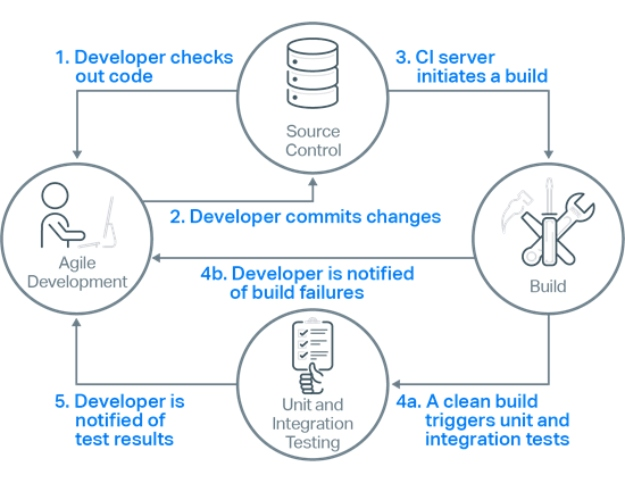 Continuous Integration
Continuous Integration
For example, when a developer commits code changes to the version control system, the CI/CD pipeline triggers automated tests to verify the new code's functionality. If any issues are identified during this phase, they are reported back to the development team for immediate resolution, ensuring that only stable and reliable code is integrated into the product.
By aligning the Definition of Done and implementing CI/CD pipelines, Agile teams establish a robust foundation for delivering software increments efficiently while upholding quality standards. These practices form a cornerstone in achieving a streamlined software delivery process that meets customer requirements and market demands in today's dynamic business landscape.
With an understanding of effective software delivery established, let's now explore how we can optimize business value delivery within Agile project management.
Optimizing Business Value Delivery
When managing multiple Scrum teams, it's crucial to ensure that they are all aligned and contributing to the overall business value. One key way to achieve this is through effective collaboration among Product Owners. Encouraging close collaboration among Product Owners helps ensure that the product backlog priorities are in sync and that release plans are aligned to maximize overall business value. When Product Owners work together, they can collectively steer the direction of product development efforts, ensuring that the focus is always on delivering high-value features to customers.
Collaborative Alignment for Business Value
Imagine a group of Product Owners working together like a well-coordinated orchestra. Each individual musician (Product Owner) has their part to play, but when they collaborate closely, they harmonize their efforts to create something truly special and impactful. This coordination helps prevent conflicting priorities and guides them toward a unified goal: maximizing business value.
For instance, if one team's Product Owner prioritizes a feature that conflicts with another team's plans, it could lead to inefficiencies in development and potential conflicts during integration. However, when Product Owners collaborate and align their priorities and plans, it results in a comprehensive product roadmap that optimizes business value delivery.
Consistent Metrics and Key Performance Indicators
Another essential aspect of optimizing business value delivery across multiple Scrum teams is the establishment of consistent metrics and Key Performance Indicators (KPIs). By having standardized metrics like cycle time, lead time, and customer satisfaction, you can effectively measure and optimize the overall value delivery. This ensures that all teams are working towards a unified focus on producing meaningful business outcomes.
Consistent metrics make it easier to compare and analyze the performance of different teams, identify areas for improvement, and track progress over time. It also provides transparency across teams and enables better decision-making based on data-driven insights.
Think of standardized metrics as the compass that guides each team's journey. Just as sailors use a compass to navigate treacherous waters, Scrum teams rely on consistent metrics to steer their efforts toward maximizing business value. Without this shared guidance, teams might veer off course or become disoriented, leading to inefficiencies and missed opportunities.
By promoting collaboration among Product Owners and establishing consistent metrics, you create an environment where every Scrum team is focused on delivering maximum business value. This alignment not only drives better outcomes for the project but also fosters a culture of collective accountability and success.
Achieving optimal business value delivery requires strategic alignment among Product Owners and the implementation of consistent metrics. These practices not only enhance project outcomes but also foster a culture of unity and accountability among Scrum teams.
What are the key factors to consider when scaling up to multiple scrum teams?
Answer: Some key factors to consider when scaling up to multiple scrum teams include effective communication and collaboration among teams, alignment of priorities and goals, resource planning and allocation, and continuous improvement through regular feedback loops. Studies have shown that organizations that successfully scale agile practices experience higher project success rates, improved productivity, and increased customer satisfaction (source: State of Agile Report).
What are some successful case studies or examples of organizations using multiple scrum teams effectively?
Answer: One successful example of an organization effectively using multiple Scrum teams is Spotify. They implemented the "Spotify Model," which involves organizing their development into autonomous and cross-functional squads, tribes, chapters, and guilds. With this approach, Spotify achieved increased collaboration, quicker time-to-market, and improved productivity. According to a case study by McKinsey & Company, Spotify reported a 20% reduction in delivery time and a 20% increase in employee satisfaction after implementing the model.
How can multiple scrum teams enhance collaboration and productivity?
Answer: Multiple scrum teams can enhance collaboration and productivity by promoting cross-team communication, sharing knowledge and resources, and fostering a culture of cooperation. This allows for better coordination and alignment of efforts, leading to improved efficiency and the ability to deliver high-quality products faster. According to a study by McKinsey & Company, organizations with collaborative teams are 5 times more likely to be high-performing.
What strategies can be implemented to ensure effective coordination and alignment among multiple scrum teams?
Answer: To ensure effective coordination and alignment among multiple scrum teams, some key strategies can be implemented. First, establishing a shared vision and clear goals across all teams helps maintain a common focus. Secondly, regular communication channels such as daily stand-ups and sprint reviews foster transparency and collaboration. Additionally, cross-team dependencies should be identified and addressed early on to prevent bottlenecks. Finally, using tools like Kanban boards or project management software can enhance visibility and facilitate coordination. According to a survey conducted by Scrum.org, organizations that effectively align and coordinate their multiple scrum teams see an average increase in overall productivity by 25%.
How can conflicts and dependencies between multiple scrum teams be effectively managed?
Answer: Conflicts and dependencies between multiple Scrum teams can be effectively managed by implementing several strategies. Firstly, fostering open communication and collaboration among teams can help identify and resolve conflicts early on. Secondly, utilizing cross-team coordination techniques such as Scrum of Scrums or Agile Program Management can provide a structured framework for managing dependencies and aligning team efforts. Lastly, having a dedicated Agile Project Manager or Scrum Master with strong facilitation skills can play a crucial role in ensuring effective conflict resolution and dependency management. According to a survey conducted by VersionOne, organizations that actively manage dependencies across multiple Scrum teams experience higher levels of project success and customer satisfaction.
When multiple scrum teams work together on the same product, each team should maintain a separate product backlog?
Answer: When multiple Scrum teams collaborate on the same product, it is generally recommended for each team to maintain a separate product backlog. This approach helps ensure that each team can focus on its specific set of priorities, commitments, and deliverables. Separate backlogs allow teams to tailor their work based on their unique context, capacity, and expertise. However, it's crucial to emphasize strong communication and coordination among the teams to align their efforts and maintain a cohesive overall product vision. Regular synchronization meetings, such as Scrum-of-Scrums, can facilitate collaboration and integration between the multiple teams, fostering a unified and coordinated approach to product development.
A product owner with multiple teams working on one product should maintain...?
Answer: A product owner with multiple teams working on one product should maintain a single, consolidated product backlog. This ensures a unified vision and prioritization for the entire product. By having a centralized backlog, the product owner can make informed decisions about feature priorities, enhancements, and overall product direction. This approach encourages transparency, minimizes duplication of effort, and allows for a more efficient allocation of resources across the multiple teams. Regular communication and collaboration with the various Scrum teams are essential to address dependencies, refine backlog items, and maintain alignment with the evolving needs of stakeholders and the market.
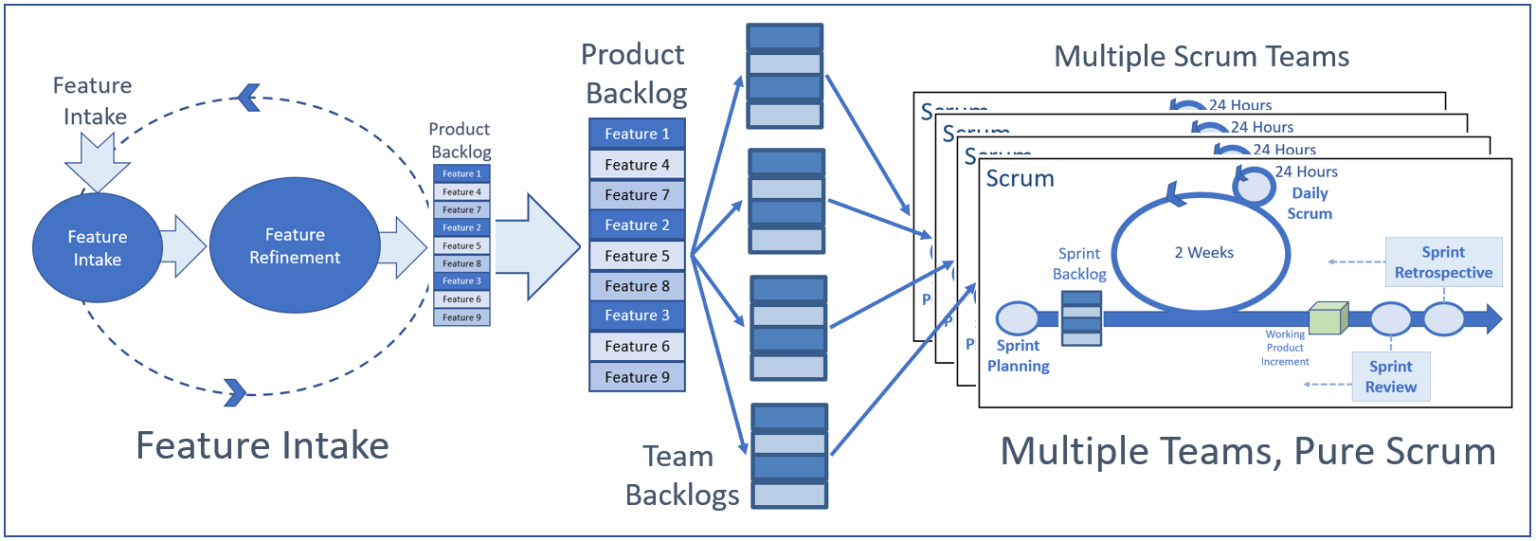 Multiple Scrum Teams
Multiple Scrum Teams
Key Takeaways from Multiple Scrum Teams
Navigating the intricate landscape of multiple Scrum teams requires a nuanced understanding of various elements within the Agile framework. As organizations embrace the principles outlined in the Scrum Guide, the roles of scrum masters, the significance of ceremonies, and the delicate balance between commitment and empowerment become pivotal. In this exploration of managing multiple Scrum teams, we delve into the ways to foster a community of self-organizing teams, the prioritization of learning, and the iterative nature of the Agile process.
Key Takeaways
- Community Building: Establishing a vibrant community is crucial for the success of multiple Scrum teams. This involves effective communication, collaboration, and a shared commitment to Agile principles.
- Roles and Responsibility: Clearly defined roles, such as scrum masters and stakeholders, ensure accountability and streamline the workflow. Understanding the unique responsibilities each role carries is essential for maintaining a well-functioning Agile environment.
- Ceremonies and Events: Regular ceremonies and events, such as sprint planning, retrospectives, and daily stand-ups, are the heartbeat of Agile development. These structured gatherings facilitate collaboration, provide transparency, and contribute to the continuous improvement of the team.
- Learning and Iteration: Embracing a culture of learning and iterative development is at the core of Scrum. Teams must prioritize continuous improvement and adaptability to deliver value to stakeholders effectively.
- Empowerment and Self-Organizing Teams: Empowering teams to be self-organizing fosters creativity and ownership. Encouraging autonomy within defined boundaries leads to more effective problem-solving and innovation.
- Prioritization and Velocity: Prioritizing tasks and understanding velocity are essential for effective project management. It ensures that teams focus on high-priority items and maintain a sustainable pace throughout the development process.
Final Thoughts for Multiple Scrum Teams
In the dynamic landscape of overseeing multiple Scrum teams, the guidance of a coach is indispensable. A coach not only steers teams towards Agile excellence but also acts as a catalyst for fostering collaboration and continuous improvement. However, the effectiveness of multiple Scrum teams thrives on more than just coaching—it requires unwavering leadership support. Leaders play a pivotal role in creating an environment conducive to Agile success. Embracing the retrospective process becomes a shared commitment, allowing teams to reflect on their performance and refine strategies collaboratively. As the journey unfolds, the synergy between coach, leadership support, and retrospectives becomes the driving force propelling the teams toward sustained growth and innovation.
The journey with multiple scrum teams is both challenging and rewarding. As you delve deeper into the intricacies of frameworks, artifacts, and the commitment to Agile values, remember that every question posed is an opportunity for learning. Embrace the self-organizing nature of teams, prioritize continuous improvement, and celebrate the ceremonies that mark each iteration. The road to mastering multiple Scrum teams is an ongoing expedition, rich with opportunities for growth and innovation. Keep exploring, keep learning, and witness the transformative power of Agile methodologies in action.
Share It With Your Colleagues and Friends to Help Them Learn:
Multiple Scrum Teams: Best Practices for Agile Projects
|
|

|

|

|

|
|
 SCRUM INSTITUTE™
SCRUM INSTITUTE™







